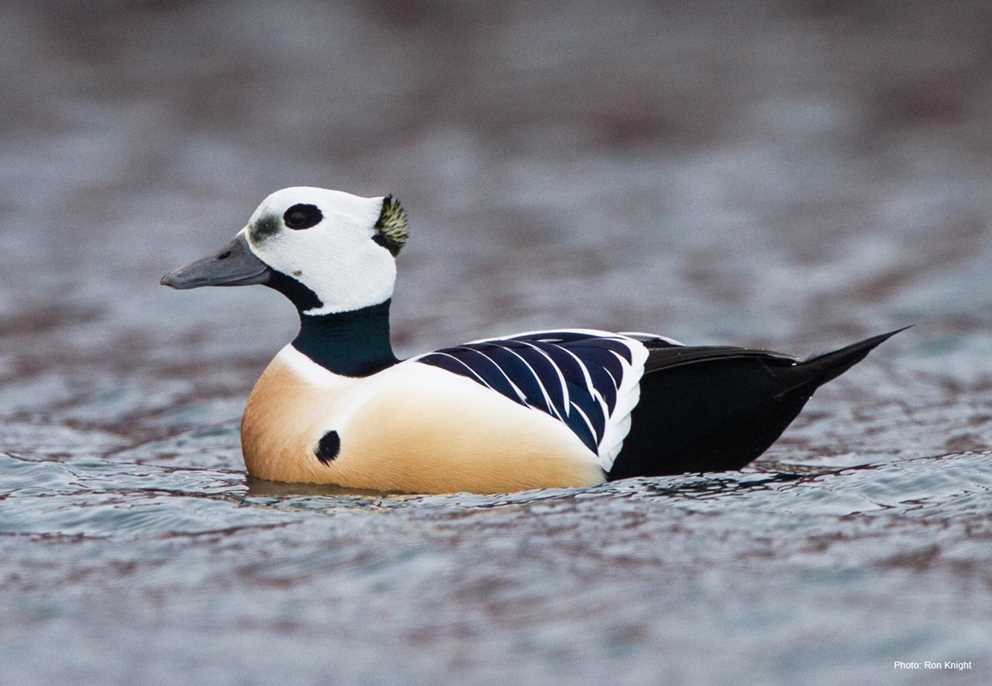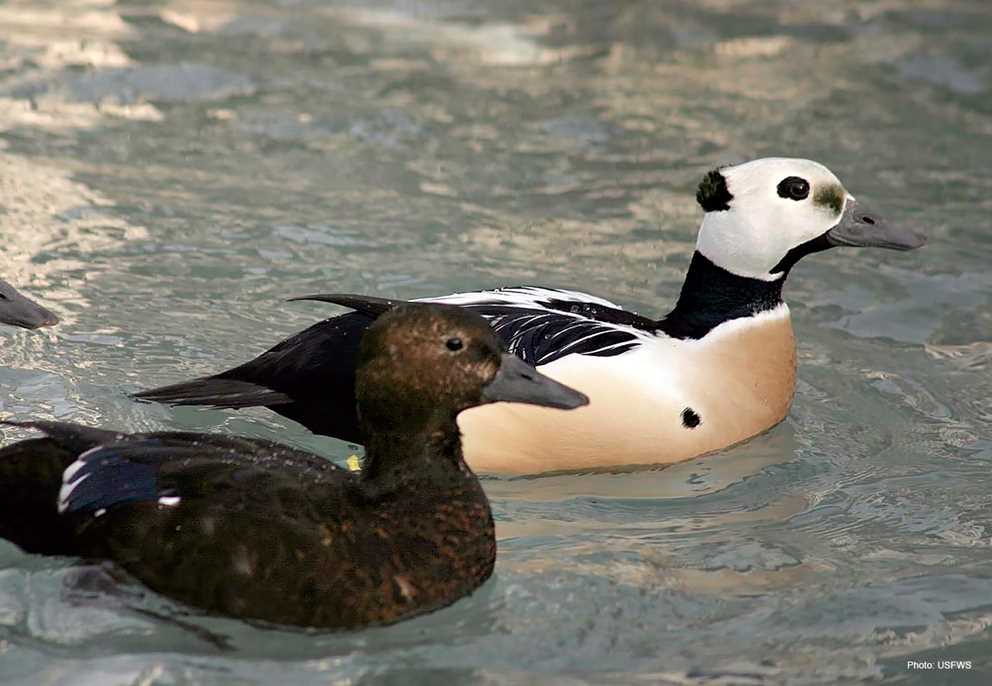Overview
The Steller’s Eider is a medium-sized diving duck and is the smallest of the four eider species. It has a restricted breeding range limited to Arctic Russia and the northern slope of Arctic Alaska. In North America, they winter in the shallow coastal bays of the Aleutian Islands.
Males have a white head with a black eye patch and collar, along with an olive-green patch between the eye and bill and a small tuft on the back of the head. Their sides, breast, and belly are cinnamon buff, while the back and rump are black with white streaking. Females are mottled reddish-brown. In flight, males show large white secondary patches with metallic blue speculums, while females display brown wings with a blue speculum, like a female Mallard's wing.
Description
Key Identification Features
- Males display a white patch on the secondary coverts, while females show a metallic blue speculum with white edges.
- Males have a white head with a black eye patch, an olive-green spot near the bill, cinnamon buff breast and sides, and a black and white streaked back.
- Females are mottled reddish-brown, sometimes with a buff eye ring and stripe, and a metallic blue speculum.
Male/Female Average Length and Weight
- Weight: Males 1.5–2.2 lbs.; Females 1.4–2.1 lbs.
- Wingspan: Males 27.5–30 in.; Females 27 in.
Male Identification
- Alternate (Breeding) Plumage: Males have a white head, black eye patch, olive-green lore patch, and cinnamon-buff sides and breast. The back is black with white streaks, and the bill is dark grayish-blue with a lighter nail.
- Basic Plumage: In summer, males molt into a dull brown plumage with grayish-blue bills, becoming cryptic.
Female Identification
- Females are mottled reddish-brown with a metallic blue speculum, buff eye ring, and eye stripe.
In-Flight Identification
- Male: Displays a large white patch on the secondary coverts and a metallic blue speculum edged in white.
- Female: Brown wings with a blue speculum edged with white, resembling a female Mallard’s wing.
Vocalizations
- Female Calls: In winter flocks, females make harsh, guttural growling sounds, likened to a growling dog.
- Flight Sounds: Wings may produce a whistling noise in flight.
Habitat Preferences
- Breeding: Found in tundra wetlands consisting of interconnected ponds.
- Migration and Wintering: Wintering occurs in shallow lagoons, tidal bays, and extensive tidal flats in the Aleutian Islands.
Foraging Habits and Diet
- Breeding Season: Feeds heavily on invertebrates, though this is poorly studied.
- Migration and Winter: Steller’s Eiders primarily consume invertebrates, including clams and mussels, throughout their annual cycle.
Breeding Habits
- Monogamy: Seasonally monogamous, forming new pairs each winter or spring.
- Nest Locations: Females create nest bowls lined with grasses, sedges, and lichens, adding down as laying progresses.
- Clutch Size: Typically, 5 to 6 eggs, olive-buff in color and measuring 2.4 by 1.7 in. Incubation lasts 26 to 27 days, with nests typically initiated in mid-to-late June.
Migration and Distribution
- Fall Migration: Steller’s Eiders leave Arctic breeding areas in July or August, with initial movements to molting sites before migrating to wintering areas.
- Spring Migration: Spring migration occurs in late May or early June, aligning with thaw of Arctic tundra wetlands.

Conservation Status
- IUCN Status: Vulnerable
- Population Status: The global population has declined from 500,000 in the 1960s to 110,000–125,000 birds today, with an Alaska breeding population of only 600 birds.
- Conservation Concerns: Key threats include subsistence harvest in Russia, oil spills, entanglement in fishing nets, and climate-change-induced habitat modifications.
- Conservation Focus: Conservation initiatives focus on protecting Arctic breeding habitats and wintering areas in the Aleutian Islands.
Harvest Information
- No harvest. Steller’s Eiders are listed as "Threatened" under the US Endangered Species Act, and hunting this species is illegal.


